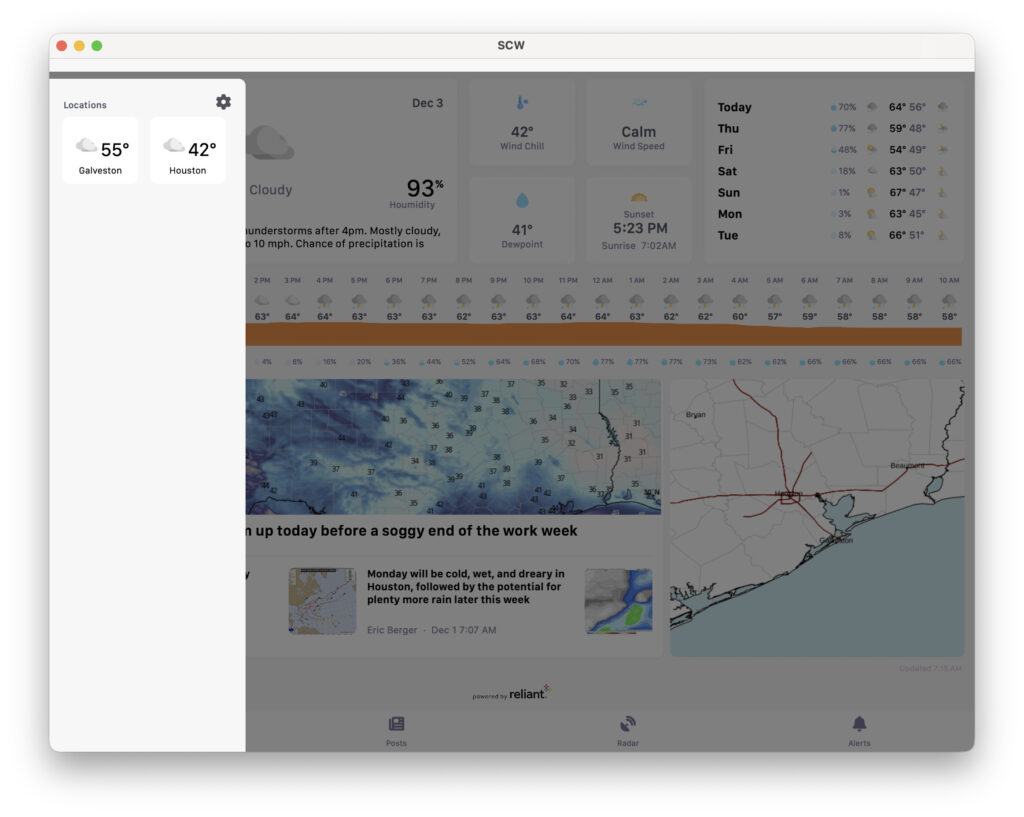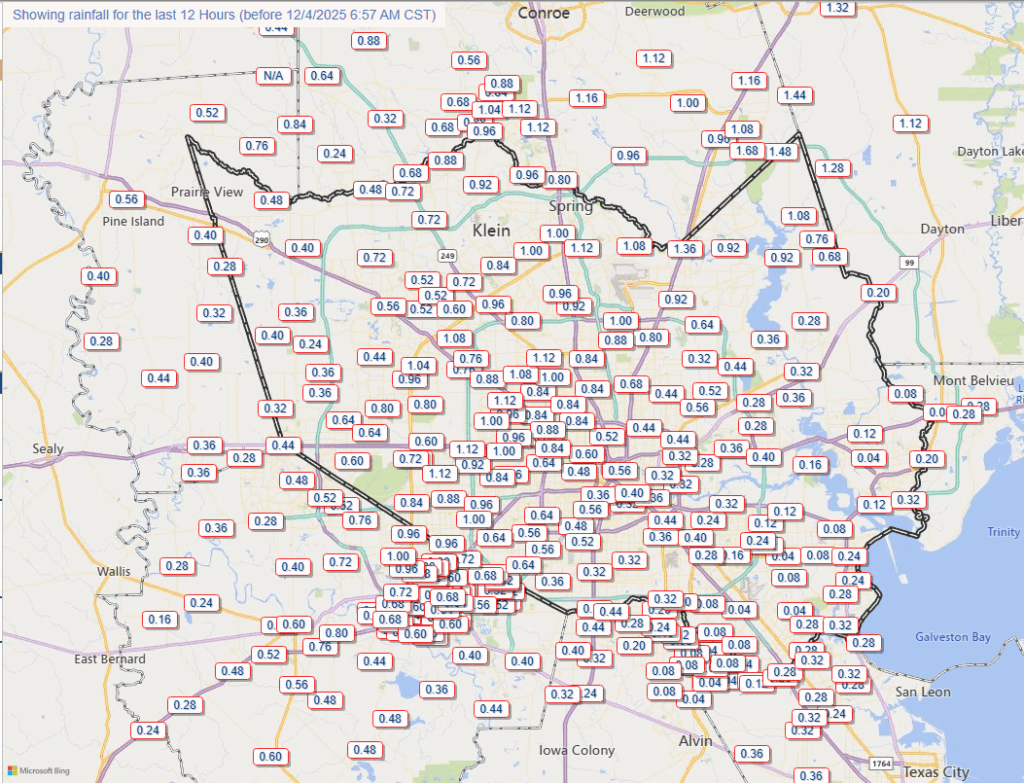In brief: In today’s post we discuss this morning’s chilly start, and our warming trend through Saturday. We also provide some clarity on the weekend forecast. And finally, our Dwight Silverman explains what the heck happened to the cities in the Space City Weather App.
Encyclopedia Brown and the Case of the Missing Cities
We love a mystery, except when it involves weird problems with the Space City Weather app. We do, however, love a mystery when it’s solved.
Users of the app noticed that, over the past couple of weeks, the list of cities available to choose in the left-hand tray would be decimated to just a few, but by the end of the day the full list would be restored.

Initially, we thought this had to do with a new version of the National Weather Service’s Application Programming Interface, or API, which is how we get the data that populates the current conditions and forecasts on the app’s home page.
Then we found the problem, and it was ours, not the NWS’, fault (sorry, y’all!).
It turns out the strange case of the vanishing cities was caused by a bug in the app that was triggered when the temperature values coming from NWS drop below a certain point—something we couldn’t easily test for when it the new version of the app was under development because the weather was warm (which it seems to be in Houston until at least November).
The app calculates Heat Index and Wind Chill differently (they show up in the same box in the conditions portion of the home screen). When temperatures dropped and the app switched over from the Heat Index to Wind Chill, it generated a value that the app didn’t understand. It then quit showing the cities where it was cold.
But as the day warmed up and the current temps rose to the Heat Index threshold, the correct values were generated and the cities reappeared. Which is why, during the day, we’d have more and more cities return to the picker.
Our developer Hussain Abbasi has fixed the bug and a new version is now available in the Android and Apple app stores.
Thanks to everyone who sent reports via the Feedback selection in the app’s Settings page. Also, we’ve been tracking the progress of the issue in the App Feedback category in our Discourse forum. If you’re having an app issue, always check there for possible enlightenment.

Tuesday
Much of our region outside the urban core of Houston, and away from the coast, has fallen into the 30s this morning. It is quite chilly, although for virtually everyone it remains above freezing. Already light winds have already shifted to come from the east, and will soon shift from the south. Thus we will begin a warming trend that will persist into the weekend before another front arrives.
With sunny skies, temperatures today will rise into the mid-60s for much of Houston. Humidity levels will remain relatively low, and temperatures tonight will drop to around 50 degrees in the city, with slightly cooler conditions for outlying areas.
Wednesday and Thursday
A weak front on Wednesday will slow down a full-on warming trend. Accordingly, Wednesday and Thursday should be pleasant days with mostly sunny skies and highs in the low- to mid-70s. Humidity will be reasonably low, and nights should be in the 50s. With partly to mostly sunny skies, these should be mild, very pleasant days.
Friday and Saturday
With a more robust onshore flow setting up later in the week, these should be partly sunny and warmer days, with highs generally in the upper 70s. As dewpoints push upward to about 60 degrees, it will feel modestly humid. Nighttime lows will probably only fall to around 60 degrees. Rain chances, as they are all week, will remain near zero. By later on Saturday or Saturday night we’ll be on the lookout for the arrival of a stronger front.

Sunday and next week
In the big picture, a large slug of very cold Arctic air is going to surge into the midwestern United States by Friday and Saturday this week. We are talking about lows in the vicinity of -15 to -20 degrees in places like Illinois and Iowa by Sunday morning. The thing we have been watching down here in Texas is how far this very cold air will reach, or whether it will largely be shunted away from us to the east.
I don’t have 100 percent confidence, but at this point I think we are at least going to see a glancing blow. This won’t be a full-on Arctic front therefore, but even a glancing blow with this airmass should cool us down. Some of the more aggressive AI modeling brings us all the way down into the 30s by Monday morning, whereas some of our more conventional models are warmer.
Anyway, at this point I think the front will probably move in some time on Sunday, roughly. This will introduce some rain chances, but I’d bet Sunday is still at least partly sunny. Let’s go with highs in the 60s and then lows (roughly speaking) in the 40s on Sunday night. The early part of next week looks chilly, and we also might see some additional, mostly light rain showers as moisture overruns the lower levels of the atmosphere. Conditions likely warm up during the second half of the week.
A message from Reliant
Reliant is helping Houston light up the holidays and give to those in need.
Through the concourse and onto the field, to Daikin Park we go! Have an Orbit-obsessed family member? Reliant has teamed up with the Houston Astros to create a picture-perfect moment with everyone’s favorite alien mascot at Houston’s newest holiday celebration, Astros Light Up the Park. Use your photo for your holiday card or give it to the biggest Astros fan in your life! Orbit brings his signature silliness and Astros pride to Monday nights only, so don’t miss your chance for a festive photo-op. Date-specific tickets through January 4 can be purchased at https://www.mlb.com/astros/tickets/light-up-the-park.
If you want to get into the giving spirit, join Reliant in supporting the KHOU 11 Secret Santa Toy Drive. KHOU 11 is leading the charge with The Salvation Army, Reliant and others to give the gift of holiday memories and bring joy to those who need it most this time of year. You can donate by visiting The Salvation Army website or drop off new, unwrapped toys at a variety of locations throughout Houston no later than Saturday, December 13.
Reliant is committed to giving back and making a positive impact in communities across Houston. We’re thankful to celebrate with you and help light up Houston during this festive season. May your holidays be bright, jolly, and full of cheer! #ReliantLightsYourHolidays






